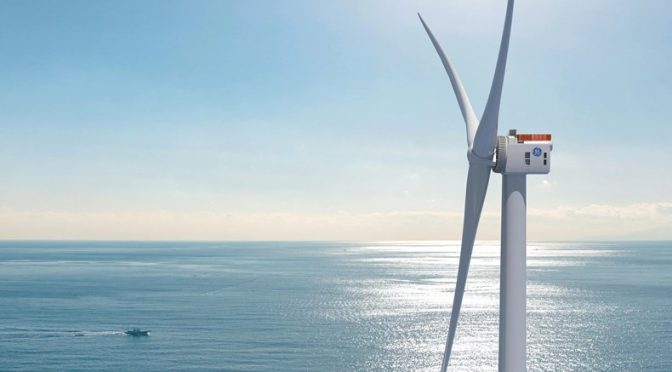With the first power at “the world’s largest offshore wind farm” announced this month, there is finally some enthusiasm in the wind energy sector. Following months of pessimism around high material costs, low profits and mechanical issues at wind farms, the sector is seeing the results of a huge investment, as the massive Dogger Bank Wind Farm in the U.K. comes into operation. But what’s next to come in the world of wind? As several countries worldwide look to diversify their energy mix and boost their renewables’ capacity to meet the growing demand for green energy, many are investing heavily in offshore wind farms and innovative turbine technology.
This month, Dogger Bank, the “world’s largest offshore wind farm”, came online. It is located off the coast of northeast England in the North Sea and is being constructed in three phases, expected to have a total capacity of 3.6 gigawatts once fully operational and power as many as 6 million homes a year. A fourth phase of the project, Dogger Bank D, has also been proposed. The project is a joint venture between SSE Renewables, Equinor and Vårgrønn, which hold a stake of 40 percent, 40 percent, and 20 percent respectively.
The companies chose GE Vernova’s huge Haliade-X turbines to be used in the farm, with the giant blades measuring 107 metres. This is the latest of many wind projects worldwide to use large, innovative blades, with companies hoping to generate more electricity using fewer turbines. The Dogger Bank Wind Farm Project stated in an announcement, “The project’s first turbine at Dogger Bank A started turning and producing electricity at 8.37 pm BST on Saturday 7 October.” It added, “Power from the first offshore wind turbine is now being transmitted to the UK’s national grid via Dogger Bank’s high-voltage direct current … transmission system, marking the first-time use of HVDC technology on a UK wind farm.”
The U.K. has attracted investments from several companies looking to expand their wind energy capacity in recent years thanks to its well-established wind sector, good windspeed, long coastline and relatively shallow seabed. Existing offshore wind projects include the Hornsea 2, a fully operational, 165-turbine facility with acapacity of over 1.3 GW. This was previously labelled as “the world’s largest installed windfarm” by Danish energy firm Orsted.
Several countries around the globe are looking to follow in the U.K.’s footsteps by developing their offshore wind capacity. Many countries that have already embraced wind energy through the construction of onshore wind farms are now looking to establish new sites in both shallow and deep waters. The potential for developing vast amounts of offshore wind capacity reflects significant innovations in wind turbine technology over the last decade. Several improvements have been made to wind energy equipment thanks to heavy investments in the sector worldwide.
In September, the U.S. Department of Energy’s (DoE) Wind Energy Technologies Office selected 15 projects, awarding a total of $27 million to address key deployment challenges for offshore, land-based and distributed wind technologies. The scheme is funded through President Biden’s Bipartisan Infrastructure Law. In 2021, the Biden administration announced efforts to reach 30 GW of offshore wind energy capacity by 2030. This is a hugely ambitious target considering that the U.S. has just two offshore wind farms in operation at present.
The EU has also announced support for the accelerated growth of Europe’s wind energy capacity. During the State of the Union address in September, the European Commission President, Ursula von der Leyen, stated“We will put forward a European Wind Power package – working closely with industry and member states.” As part of the package, der Leyen vowed to fast-track permitting even more; improve auction systems across the EU; and focus on skills, access to finance and stable supply chains. While some countries, such as Denmark, Germany, and the UK, are way ahead when it comes to wind energy, other countries, such as Latvia and Italy, are lagging behind and require support from the EU to spur growth.
The EU’s neighbour, Norway, is hoping to establish the largest floating offshore wind power projects in the coming years, a feat that once seemed impossible. Most offshore wind turbines are fixed directly to the sea floor in relatively shallow depths. However, floating turbines can be deployed in very deep waters, where the wind is much stronger, and communities won’t complain about their shoreline being destroyed. Norway hopes to construct the Hywind Tampen floating wind farm around 90 miles off the coast in the North Sea. Giant turbines will be connected to the sea floor using an extremely heavy-duty chain attached to “suction anchors” that burrow into the sand.
As news of the first power at a massive new offshore wind farm is announced, the wind sector is feeling greater optimism about its ambitious wind capacity targets over the coming decades. Despite high material costs and several hurdles faced over the last three years, the high levels of funding in the research and development of wind energy technology, as well as significant investment in massive new projects, is finally beginning to pay off, with governments showing increasing support for the sector and several major achievements expected to take place over the next few years.
By Felicity Bradstock for Oilprice.com


